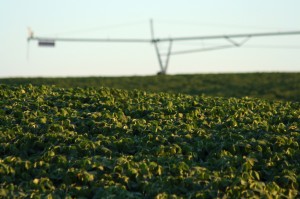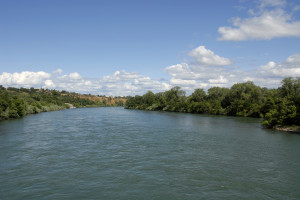
Farmers across the state aren’t getting much of a post-planting reprieve, as temperatures continue to heat up and rainfall continues to stay away lately across most of the Cornhusker state. As such, irrigation motors are firing up rapidly as producers fret about their emerging crops amidst the hot, dry conditions.
Peer pressure is most certainly a factor, it seems, when it comes to irrigation. Many producers convince themselves that their soil moisture is adequate for another day or two, but when the neighboring pivot fires up that evening, it can be difficult to not follow suit.
Many times, however, soil moisture conditions are adequate, and, increasingly, farmers across the state and nation are trading in guessing for certainty by utilizing the latest moisture monitoring technology, with significant cost-saving results.
A popular source for this innovation around Nebraska is through San Diego-based company AquaSpy, whose high-tech soil moisture probes deliver real-time data to producers, revealing the detailed moisture content and temperature of their fields at different depths and times of day. Farmers are then able to determine vital information about their crops, including how deep the roots have penetrated and how well the plants are utilizing the fertilizer at varying depths.
This probe-data is wirelessly sent in real-time to an easy-to-manage dashboard, which may then be accessed on any computer or mobile device, allowing users to monitor their fields at any time and place.
Armed with this detailed analysis, producers are able to actively manage their irrigation efforts based on hard data, not conjecture.
North-Central Nebraska farmer and AquaSpy user Tim Schmeeckle revealed that he ran his center-pivots three fewer times with AquaSpy than the year before. With the costs associated with pumping and labor to run each pivot estimated to be around $1,000, Schmeekle estimates a savings of $30,000 that year.
“It is kind of like a fuel gauge on your car,” he said. “We know how much moisture we started with. We know how much the roots are taking out of the ground, and we know how deep we are putting that water back in.”
The Nebraska Ag Water Management Network has estimated a water-savings of 2 inches per acre for those utilizing any soil moisture monitoring technology—a cost saving measure that adds up to $10-$30 per acre.
According to the University of Nebraska-Lincoln’s Institute of Agriculture and Natural Resources, moisture sensor technology not only reduces pumping costs, but may also improve crop growth and yield by helping farmers avoid the detrimental effects caused by overwatering upon soil conditions and nutrient leaching.
Producers who are ready to give such technology a try are encouraged to install their sensors early on in the season to ensure proper operation. Early installation helps minimize root damage, allows time for the sensors to acclimate to the soil moisture conditions, and ensures a better chance for proper soil contact.
Controlling input costs and keeping a tight rein on irrigation output has a significant effect on a producer’s bottom line—now more than ever. If you are considering utilizing moisture sensing data into your operation, please let us help you decide the best way to move forward with this exciting technology.
UFARM offers a full range of Nebraska land management services, including real estate sales, rural property appraisals, consultations and crop insurance. UFARM has operated in Nebraska since the early 1930’s. If you have questions about yields and productivity on your rented farmland, give the UFARM managers contact us today!
Sources consulted: Freeman, Mike. “Drought-Stricken Fields Get Boost From Technology.” The San Diego Union-Tribune. The San Diego Union Tribune. 17 Jul. 2014. Web. 13 Jun. 2017. Nygren, Aaron. “Value of Using Sensors for Irrigation and Tips for Proper Installation.” Cropwatch. University of Nebraska-Lincoln. 8 Jun. 2017. Web. 13 Jun. 2017.

 Landowners are always endeavoring to get the most from their farmland, and this is especially true when negotiating cash rental rates with potential tenants. While there are many factors in play when it comes to lease rates, one of the most significant is whether or not their parcel of land is under center pivot irrigation. As many savvy landowners readily discover, there is a strong correlation between higher cash rental rates and the presence of center pivot irrigated acres.
Landowners are always endeavoring to get the most from their farmland, and this is especially true when negotiating cash rental rates with potential tenants. While there are many factors in play when it comes to lease rates, one of the most significant is whether or not their parcel of land is under center pivot irrigation. As many savvy landowners readily discover, there is a strong correlation between higher cash rental rates and the presence of center pivot irrigated acres.
